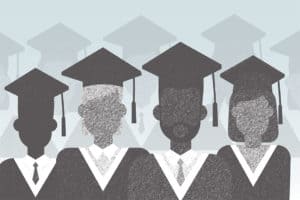
Within the research projects of doctoral students in library and information science lie ways to mitigate the challenges of an inequitable world. Too often, these valuable findings go underused. That’s why, each year, American Libraries highlights the top dissertations that can make a difference—for rural areas, indigenous communities, people experiencing homelessness, and many other populations.
This year’s crop includes research on the power of reading, librarian–teacher collaborations, and school librarians as academic leaders. The nine dissertations selected from digital archives and online databases have practical implications for school, public, academic, and special libraries; feature quantitative, qualitative, and mixed methodologies; and include measurable recommendations for change.
The students and their topics are:
- Reham Isa Alshaheen (Simmons University in Boston) analyzed the user experience and information architecture of national library websites.
- Carolina Barton (Concordia University Irvine in California) studied success factors in the transformation of academic libraries into learning commons.
- Angel Krystina Washington Durr (University of North Texas in Denton) researched the challenge of identifying skill sets for data-science jobs.
- Melanie Ann Lewis (Liberty University in Lynchburg, Virginia) examined the role of school librarians as academic leaders.
- Sandra Littletree (University of Washington in Seattle) explored the historical development of tribal libraries, with a view toward the design of current and future library services.
- Shelly Lynne McMullin (University of North Texas in Denton) considered similarities in information literacy and critical thinking skills.
- Jessica M. Ross (University of Alabama in Tuscaloosa) studied the challenges of information dissemination in rural communities.
- Jeanna Wersebe (University of California, San Diego) examined factors that contribute to successful collaboration between school librarians and teachers.
- Deborah W. Yoho (University of South Carolina in Columbia) found that reading provides a powerful respite in the lives of marginalized library patrons, such as people experiencing homelessness.

Reham Isa Alshaheen
PhD, Simmons University
“User Experience and Information Architecture of National Library Websites”
Summary: Using methods such as content inventory, web information architecture assessment, and participant usability evaluation, Alshaheen analyzes the user experience and information architecture of 28 national library websites. The study examines the websites’ structure, menus, colors, and information quality, as well as how deeply users trust the sites’ content and the entities generating that content. Users were satisfied with the overall quality of these websites, though users who differed in age, gender, and educational background differ in their ratings of the sites. This dissertation provides a list of content elements that commonly appear on national library websites as well as a practical procedure to evaluate these sites.
Recommendations: Alshaheen recommends regular usability testing of national library websites with a view to understanding the needs of all users. For example, national library websites serve not only graduate students and researchers but also teachers, teenagers, professional workers, and older adults. Other factors to consider include readability for global users, standardizing date formats across countries, and the trustworthiness of content. Menu construction should be easily understood and not too complex. Designers should stick with one language per page and eschew jargon, excessive information, and animations. (The latter can be distracting and confusing.)

Carolina Barton
EdD, Concordia University Irvine
“Transforming an Academic Library to a Learning Commons Model: Strategies for Success”
Summary: In an effort to cope with the speed of technological change, some academic libraries are transforming themselves into learning commons. Barton uses a mixed-methods approach to identify successful strategies such as deploying surveys to understand student needs, gaining administrative support, ensuring the presence of adequate technology, encouraging collaboration among library staff, introducing a café, and changing policies around food and noise in the library. Obstacles to success include inadequate funding, resistance among stakeholders and staff, difficulty in building partnerships with stakeholders, and ineffective teams.
Recommendations: Barton recommends a three-phase approach to developing a learning commons. Phase one is the time to research information, build a shared vision and strategic plan, gain leadership’s support, and secure resources. In phase two: design a welcoming, technology-rich, and flexible environment, with moveable furniture, group learning spaces, service desks, a sufficient number of power outlets, and virtual learning resources that are available 24/7. Phase three includes a technology plan to keep computers, printers, and other equipment up to date and in working condition. Further research is recommended to determine the effective development of staff members who work in a learning commons environment, as well as the best way to manage the sustainability of a learning commons.
Editor’s note: Barton died October 7, 2018.

Angel Krystina Washington Durr
PhD, University of North Texas
“A Text Analysis of Data Science Career Opportunities and US iSchool Curriculum”
Summary: The proliferation of data requires the presence of data scientists—not only to manage and maintain it but also to make it available to those who need it. Durr posits that because there is no universal path to a data-science career, getting the right training for such a career can be challenging. Comparing iSchool course syllabi with data-science job postings, Durr finds that many of the skills required in these jobs are addressed in iSchool syllabi, with some topics receiving greater or lesser emphasis in each arena. The phrases ICT (information and communications technology) and machine learning appear more often in iSchool syllabi than in data-science job ads, while the phrase programming languages appears more often in data-science job ads. Also appearing more frequently in job ads than in iSchool syllabi is the word experience, suggesting that it would be wise for iSchools to provide more opportunities for hands-on experience.
Recommendations: One of the study’s recommendations is the development of a competency-based framework for the education of data-science professionals. A network of data-science employers and iSchool program developers could, first, add needed job skills to the iSchool curriculum, and second, help educate employers about additional skills that iSchool students may possess.
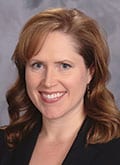
Melanie Ann Lewis
EdD, Liberty University
Summary: California school administrators assign leadership duties to both instructional coaches and teacher-librarians. This collective case study compares those roles in the context of implementing the California Common Core State Standards in English language arts. Lewis asks why administrators select instructional coaches and teacher-librarians for this task, and how these coaches and teacher-librarians collaborate to fulfill it. As Lewis shows, while administrators may choose either instructional coaches or teacher-librarians to fulfill this task, they prefer instructional coaches, viewing them as instructional leaders similar to themselves, while teacher-librarians are considered instructional resources to be called on only occasionally.
Recommendations: Lewis recommends that library media specialists actively promote school library research to district stakeholders. Students in teacher and administrator education programs need to learn about the instructional role of the teacher-librarian. School districts should develop and use appropriate job descriptions and evaluations to define and assess teacher-librarians. Further research might examine barriers or limitations that coaches and teacher-librarians encounter when providing instructional leadership.
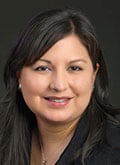
Sandra Littletree
PhD, University of Washington
Summary: Using qualitative methodologies informed by indigenous approaches to knowledge, Littletree traces the history and development of tribal libraries. As she explains, in the 1960s it was found, first, that library services for American Indians were inadequate, and second, that federal responsibility for Indian education included the responsibility to improve these services. By the 1970s, the country was in an era of self-determination, when people and communities were empowered to make their own choices, and American Indian library leaders, educators, community members, and allies sought opportunities with the US president and Congress to address the need for improved tribal libraries. Littletree notes that the 1978 White House Preconference on Indian Library and Information Services on or near Reservations may have been the most important step in the formation of tribal libraries.
Recommendations: All libraries face challenges—for example, the advent of ubiquitous technology. Tribal libraries face these same challenges, plus other obstacles unique to their own communities. Littletree recommends the development of a vision to provide tribal leaders and librarians with paths toward excellence for tribal libraries; for example, it may be time to consider a new National Indian Omnibus Library Bill. Tribal librarians could network with iSchools and LIS programs to incorporate the information needs of indigenous people and leadership for tribal librarians into the curriculum. Further research could explore effective leadership qualities in tribal librarianship, as well as the role of tribal councils in supporting library and information services in the community.
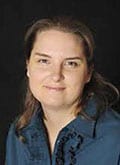
Shelly Lynne McMullin
PhD, University of North Texas
Summary: In college learning, information literacy skills and critical-thinking skills are both important for success. Academics tend to believe the two skill sets are inherently related; however, to date, little evidence has supported this belief. McMullin uses an exploratory, mixed-methods approach to study the differences in information literacy and critical-thinking skills, as well as gender differences that might occur within each skill set. In addition to surveys, scores from two standardized tests—the California Critical Thinking Skills Test (CCTST) and the Standardized Assessment of Information Literacy Skills (SAILS)—are analyzed, along with student survey results. McMullin finds that students perform better on the CCTST than on the SAILS, even though the CCTST is considered more difficult. Her results show a statistically significant correlation between the tests, providing evidence that information literacy skills and critical-thinking skills may be inherently related in some categories.
Recommendations: While critical-thinking skills and information literacy skills are imperative, academic professionals may need to change how these skills are taught. As cognitively linked constructs, the two skill sets could be taught in tandem. K–12 teachers may also consider providing learning experiences that marry information literacy with critical thinking.

Jessica M. Ross
PhD, University of Alabama
“The Role of Public Libraries in Rural Communication Infostructure”
Summary: In rural communities without an integrated information infrastructure, or infostructure, it can be challenging for institutions to communicate accurate, up-to-date news and information. This exploratory, qualitative study examines how members of these communities create and disseminate information, as well as how they prefer to receive information. As the study notes, in close-knit communities there may be an information access gap for newcomers. As a result, marginalized people, including children, may be less informed about community news and information. Traditionally, public libraries are perceived as inclusive places; Ross’s study affirms this perception.
Recommendations: Public libraries are perceived as welcoming places and provide a variety of information resources. Libraries can leverage these assets to serve those new to a community. Those assets may include programming that reflects the needs of minority populations as well as language assistance such as interpreters for programs and homework. Outreach programs can effectively welcome people to the community and provide awareness of what the library can offer them.

Jeanna Wersebe
EdD, University of California, San Diego
Summary: Wersebe seeks to understand how high school teachers, administrators, and teacher-librarians define collaboration, as well as the factors that contribute to successful collaboration. Results show that positive relationships among teachers, leadership, support staff, and students boost the success of collaborations. Other positive factors include a staff that values collaboration, support from leadership, knowledge of the teacher-librarian’s role and skill set, and a positive school culture. One barrier to successful collaboration: the view of the school library as merely a warehouse of books. Other barriers include lack of opportunities to collaborate, negative past experiences, and inflexible procedures.
Recommendations: Teacher-librarians are in leadership roles and can be proactive in providing opportunities for collaboration. They have a responsibility to educate administrators, teachers, and students about the skill sets and proficiencies that define their role. Building positive relationships has long been the purview of the teacher-librarian, and this ability will enhance collaborative ventures. Administrators can improve collaborative relationships by inviting teacher-librarians to meetings about curriculum writing or new programs. Educational leadership programs in colleges and universities should provide discussions and readings of the teacher-librarian impact on student achievement. Teacher education programs might offer preservice activities that include collaboration with teacher-librarians. Further research into high school collaborations should be conducted, using varying methodologies and samples.
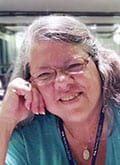
Deborah W. Yoho
PhD, University of South Carolina
“Intersection: Reading and Adult Homelessness and Public Libraries”
Summary: Public librarians seek to provide equitable access to all patrons, including those experiencing homelessness. In this qualitative study, Yoho documents the power of reading for transitional and homeless populations. She finds that reading provides a distraction from negative feelings of loneliness, melancholy, and boredom; temporarily allows the reader to mentally “transport” out of negative experiences; helps manage the personal behaviors that may be necessary to obtain social services; and ameliorates stress by providing calm and comfort in uncertain circumstances.
Recommendations: Yoho recommends training librarians to serve patrons from vulnerable populations, such as those experiencing homelessness. There may even be a role for social-service training in LIS programs, though some may be more comfortable revisiting library policies to determine how to handle the social-services expectations of public library patrons. She recommends reviewing library policies and procedures around patron disruptions and complaints, as well as staff attitudes toward inclusiveness and outreach. In addition, she recommends creating programs that meet the digital literacy needs of vulnerable populations such as the homeless.


